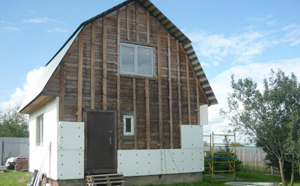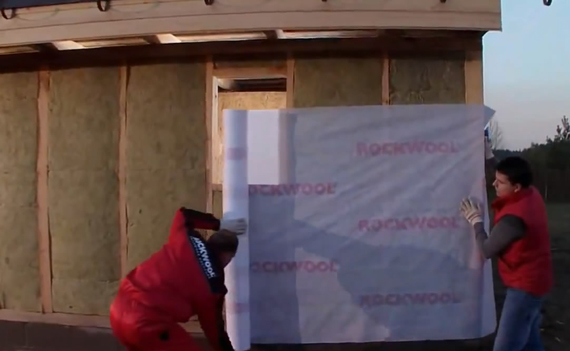There are often situations where walls in a wooden house lose one of their tasks, such as keeping heat. In this case, they resort to insulating the walls of the house from the outside. Insulation becomes protection from cold air.
This solution to the problem also has several more advantages: the wall of the building gains additional protection from sunlight and dampness and will last longer.
Advantages of external thermal insulation
External insulation of a house has several advantages:
- The main thing among which, of course, is the preservation of heat. This type of insulation prevents a sharp drop in temperature... The wall, reinforced from the outside, retains a high thermal protection.
- Unlike internal insulation, with external insulation there are no areas in which there is no heat, the so-called "cold bridges" since with this type of insulation it is possible to install heat-insulating material in the places where the floor joins the outer walls.
- Also, external insulation prevents the penetration of moisture into the walls of the house.
Do not forget about the disadvantages of outdoor insulation. This process of insulating wooden houses is rather complicated and time consuming.
Warming methods
There are several types of insulation:
- The insulator is mounted on the wall with an adhesive solution.
- Facade ventilation. The wall is protected with waterproofing, insulation is attached from above, a windscreen is installed, after which siding or other material is installed on the frame.
- Three-layer non-ventilated wall. The insulation is fixed with mortar, the outer wall is mounted in one brick, while observing the air gap.
It is natural that for each type of material has its own subtleties in performance... It should not be ruled out that there are combined insulating materials on the market for insulation products, or such materials for which it is necessary to adhere to the technology itself developed.
The big plus is harmlessness. Such insulation is environmentally friendly. The only drawbacks are high price.
Expanded polystyrene
Gas-filled material like polyurethane foam. It is obtained from polystyrene and its derivatives. Such material is vapor-permeable, absorbs water well, biologically stable, long service life. These are definitely pluses.
Of the minuses - flammability, which makes it a rather dangerous material.
Styrofoam
The most popular material for external insulation of wooden houses. It has a cellular structure because cells are insulated, foam has good thermal insulation, which is definitely its plus.
Also, foam insulation gives good sound insulation, no need for additional waterproofing, ease of installation and durability.
Like all materials, polystyrene has its drawbacks: it is unsafe. when burning, corrosive substances are released, has low strength.
When choosing a heat-insulating material, you should pay attention to its service life, safety. The choice of material for insulation should be approached responsibly, to study all the pros and cons. Preference should be given fireproof and environmentally friendly materials.
Do you know what is the best way to sheathe a wooden house outside? Read this article.
We insulate a wooden house with our own hands
Insulation technology begins with the installation of a frame on which the insulation will lie.
Bars are nailed to the wall to be treated made of wood 50x50 mm in size, keep in mind that the distance should be no more and no less than 580 mm of security. The material must be laid so that there are no gaps between the wall and the bars.
Next stage - providing vapor barrier... For this, aluminum foil, polyethylene film or vapor barrier film are used. There is no need for a vapor barrier if the house is made of round timber.
When the plane is smooth, then the slats are stuffed onto which the vapor barrier layer is mounted. It should be borne in mind that between the slats from below and from above there should be a stoma of 20 cm in diameter for ventilation. The places of fastening of the material for the vapor barrier are sealed with adhesive tape in order to protect against moisture ingress.
The vapor barrier is followed by the thermal insulation. The material must be installed so that there are no gaps and gaps between the frame boards. The material is laid in two layers of 50 mm each so that the joints of the first layer are aligned with the middle of the second.
For a secondary layer of thermal insulation bars are nailed across walls perpendicular to the main frame row.
Next is waterproofing. The waterproofing film must easy to pass steam and good water retention... A waterproofing layer is applied to the heat insulator layer. It is nailed to the frame.
Next is the stage of installing the secondary layer of the frame. On the first layer (on top of the waterproofing layer), slats 50 mm wide and 30 mm thick are stuffed.
The installation of the next layer of the frame is carried out for free air movement between the vapor barrier layer and the cladding, so that moisture trapped on the waterproofing layer is dried.
The space formed at the bottom is necessarily covered with a dense metal mesh from the penetration of rodents and insects.
At the last stage, the house is sheathed with the appropriate material (siding, lining, facade panels, and others). It should be borne in mind that wall thickness will increase by 20-25 cm and, accordingly, you need to think about the protection of the insulation from the side of the window openings.
Thermal insulation of a wooden house outside: video instruction.







